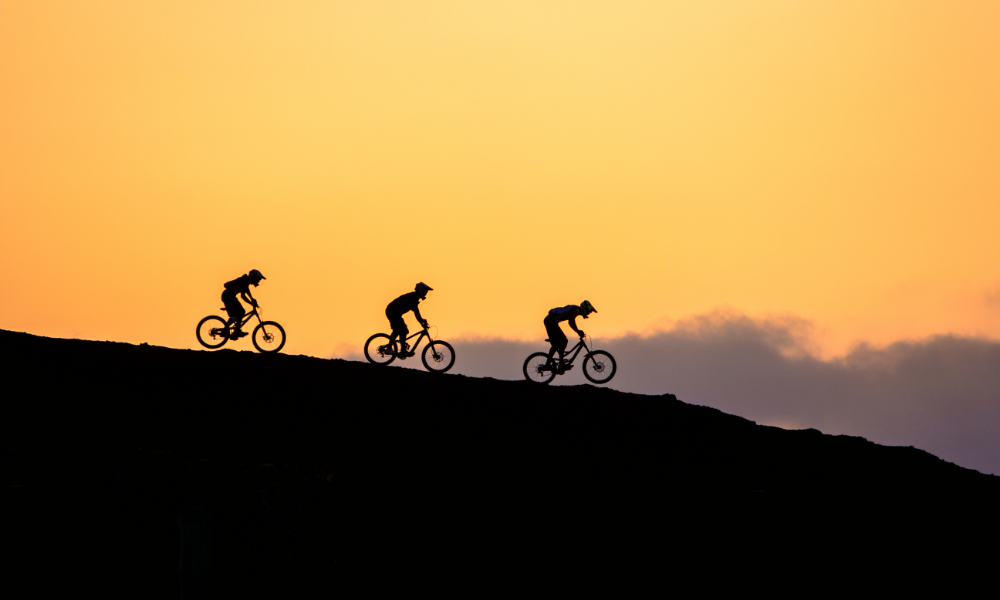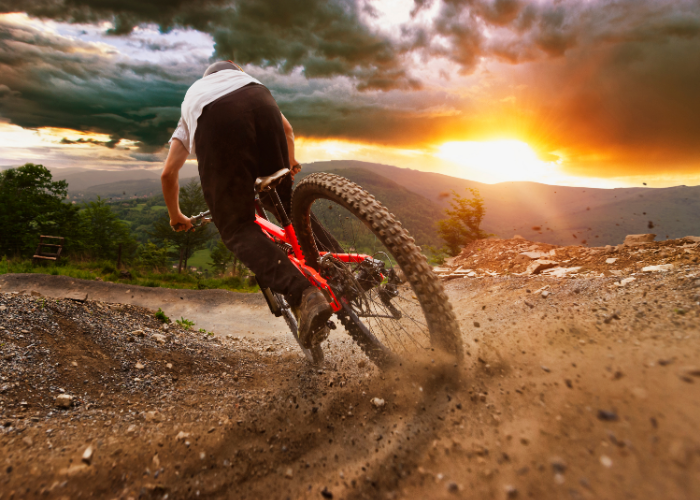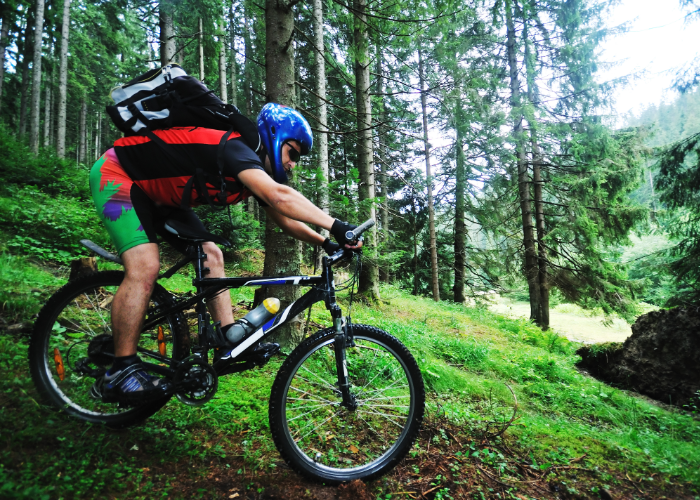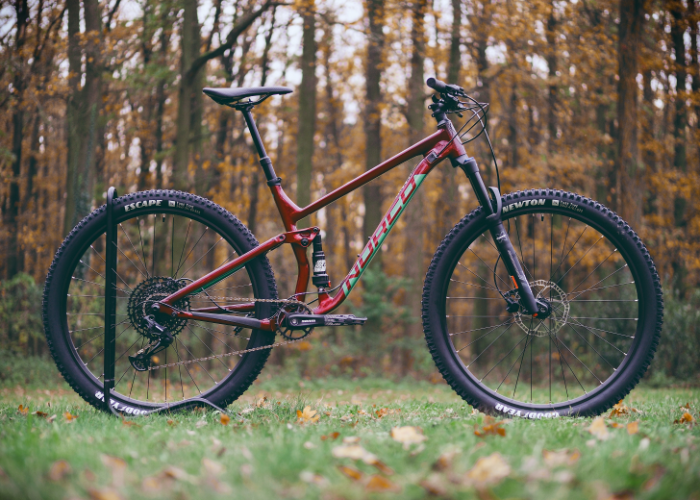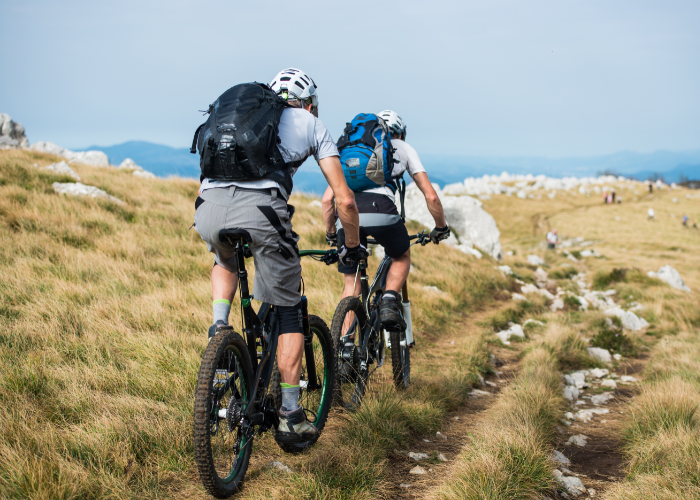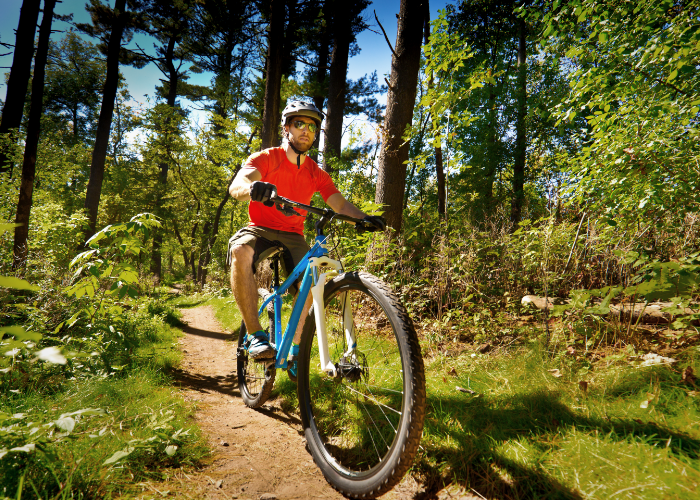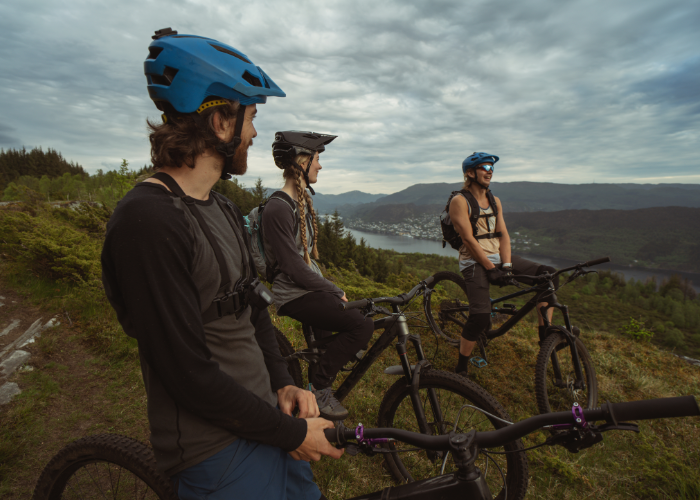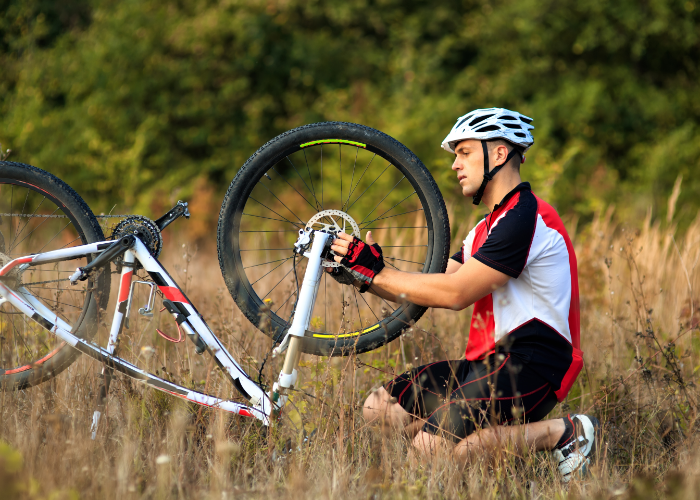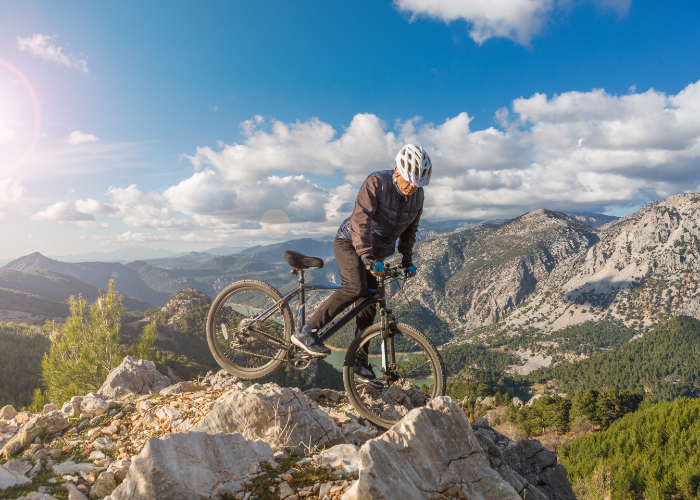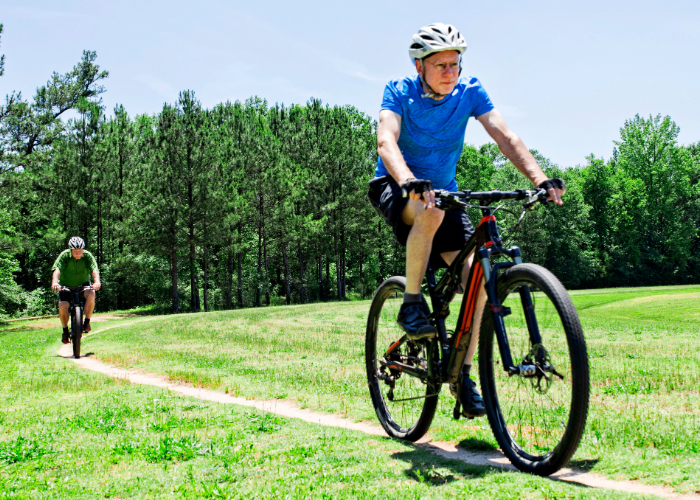Are you ready to embark on an adrenaline-pumping journey that will have you exploring breathtaking landscapes, pushing your limits, and making unforgettable memories?
Welcome to the thrilling world of mountain biking!
With numerous disciplines catering to different preferences and abilities, there’s something for everyone in this exciting sport.
Before you hit the trails, it’s essential to learn the basics, choose the right bike, and gear up for safety.
So let’s dive into this comprehensive guide on how to get into mountain biking for beginners and get ready to conquer the mountains!
Key Takeaways
- Embrace the world of mountain biking and join a passionate community to explore stunning places, have tons of fun, get fit & embark on unforgettable adventures!
- Discover different disciplines from cross-country to freeride & master essential skills for an exciting riding experience.
- Gear up with essentials like helmets & gloves before discovering beginner trails, stay safe by following trail etiquette and wearing protective gear!
Embracing the Mountain Biking World
Mountain biking is an exciting sport that involves riding bicycles off-road, often over rough mountain bike trails, and has come a long way over the years. It offers various disciplines, challenges, and opportunities for personal growth and adventure. Some of the benefits of mountain biking include:
- Exploring stunning places
- Having tons of fun with friends
- Gaining immense confidence
- Getting super fit and strong
- Visiting your local bike shop for advice and gear
From professionally built flow trails to modern geometry mountain bikes, lift-served bike parks, and even electric mountain bikes, this exciting world has it all!
Before diving headfirst into the wild world of mountain biking, it’s crucial to learn the basics to maximize fun and stay super safe when hitting the dirt for the first time. Spend some time on quiet streets or dirt roads to get comfortable on your bike before tackling more challenging mountain bike trails.
Embracing the world of mountain biking means not only enjoying the sport’s physical and mental benefits, but also becoming part of a passionate community of mountain bikers. As you venture into this exciting realm, you’ll discover new trails, make lifelong friends, and embark on unforgettable adventures.
So, are you ready to start mountain biking and join the ranks of those who have discovered the joy and thrill of this incredible sport?
Understanding Different Mountain Biking Disciplines
To fully enjoy mountain biking and find the discipline that suits your preferences and abilities, it’s essential to understand the different types of mountain biking trails and disciplines. From cross-country and trail riding to enduro, downhill, and freeride, mountain biking offers an array of exciting options for riders of all skill levels.
Each mountain biking discipline has its unique aspects and challenges. Whether you prefer:
- the endurance and speed of cross-country
- the versatility of trail riding
- the adrenaline rush of enduro and downhill
- the creativity and style of freeride
There’s a mountain biking style for everyone. As a beginner, it’s recommended to start with cross-country and trail riding and then explore other disciplines as you gain experience and confidence.
To help you navigate the diverse world of mountain biking, let’s delve deeper into each discipline, discovering their unique characteristics and what makes them so exciting. By understanding these differences, you can choose the right discipline for you and make the most of your mountain biking experiences.
Cross-Country
Cross-country mountain biking is all about endurance and speed, with riders tackling a mix of thrilling rough forest paths, exhilarating singletrack, doubletrack, fire roads, and even paved paths connecting other trails. Cross-country bikes often have a hardtail design, but a full suspension bike can also be a great choice for this discipline. The typical travel range for full suspension cross-country bikes is between 90mm and 110mm, offering riders a perfect balance of performance and comfort on various terrains.
Singletrack trails are narrow paths that offer the best balance of flow and technicality, providing riders with an engaging and challenging cross-country experience. As you venture into the world of cross-country mountain biking, you’ll discover the joy of navigating these exciting trails and pushing your limits on diverse terrains.
Trail
Trail mountain biking is the versatile and accessible discipline that features a balance of climbing and descending on natural and man-made trails. Building upon cross-country biking, trail and enduro biking put a bit more emphasis on the downhill and occasionally incorporate jumps, berms, or riding features into the mix.
One of the exciting advantages of going to a mountain bike center is the availability of graded routes of varying lengths and technical difficulty. Riders new to the sport have a great opportunity to find trails that fit their comfort and ability levels. This ensures they have an enjoyable experience without feeling overwhelmed. The color-coded system used in mountain bike centers grades trails according to their difficulty, ranging from:
- Green for easy
- Blue for moderate
- Red for difficult
- Black for severe
Enduro
Enduro mountain biking is an exhilarating type of mountain bike racing that involves thrilling timed downhill stages and long-travel bikes designed for going as fast as possible downhill on the most challenging trails around. This adrenaline-filled adventure requires both technical skills and endurance, as riders navigate steep, rough, and rowdy trails that test their limits.
To conquer enduro mountain biking, you’ll need to master the art of balancing speed and control while navigating treacherous terrain. With its mix of timed downhill sections and untimed uphill sections, enduro mountain biking pushes riders to their limits and offers a unique, unforgettable experience on the trails.
Downhill
Downhill mountain biking is adrenaline-pumping discipline that focuses on speed and technical skills on steep, challenging terrain. Downhill bikes are specifically designed for intense, fast riding, jumping, and hitting terrain features. They always have full suspension, with at least 170mm of travel.
The main difference between enduro and downhill mountain biking is the bike. Downhill bikes are made for tackling downhill terrain at speed. They are also equipped to ride through some crazy terrain. Enduro bikes, on the other hand, have been designed with versatility in mind. They can handle a variety of terrains and activities. Bike parks, with their huge jumps and terrain features, are perfect playgrounds for downhill mountain biking.
However, beginners should steer clear of bike parks, as they are intended for experts with the necessary skills and experience.
Freeride
Freeride mountain biking is the discipline that combines elements of downhill, trail, and enduro biking, allowing riders to express themselves and push their limits to the max. It involves riding and building trails with thrilling features like jumps and drops and performing awesome tricks off them.
Freeride mountain biking emphasizes creativity and style, with riders navigating natural and man-made features such as jumps, drops, and stunts. To excel in this discipline, you’ll need a good understanding of bike handling, balance, and control, as well as being comfortable with jumping, drops, and stunts.
Always remember to wear a helmet and other protective gear, and stay aware of your surroundings when practicing freeride mountain biking.
Mastering Essential Mountain Biking Skills
Developing essential mountain biking skills is crucial for enhancing your riding experience and ensuring safety on the trails. By mastering the mountain biking basics, such as body positioning, shifting weight, braking, and navigating obstacles, you’ll be well-equipped to tackle any terrain with confidence.
Body positioning is key to maintaining balance and control on your mountain bike. Shifting your weight effectively allows you to maintain traction and safely avoid accidents. Braking is also an essential skill for modulating speed and maintaining control, especially when entering turns at high speeds. Focusing on these fundamentals will lay a solid foundation for your mountain biking journey.
As you progress, you’ll also need to learn how to lock out and/or open up your suspension to ensure a smooth and comfortable ride on various terrains. Knowing how to adjust your suspension can prevent accidents and help you tackle technical trails with confidence.
Selecting Your First Mountain Bike
Choosing your first mountain bike can be an exciting yet daunting task, but with the right guidance, you’ll find the perfect bike that suits your preferences and abilities. Key factors to consider when selecting your first mountain bike include:
- The type of bike (hardtail or full suspension)
- Frame size
- Wheel size
- Frame material
Additionally, keep your budget and riding preferences in mind.
Hardtail bikes only have suspension in the front, while full suspension bikes have shocks in both the fork and the rear of the bike. As a beginner, it’s recommended to start with a hardtail bike, as they offer a more efficient ride uphill and are generally more affordable.
Don’t forget to consider factors such as the different wheel sizes (26 in., 27.5 in., 27.5+ in., and 29 in.) and frame size, as an ill-fitting bike can negatively impact your mountain biking experience. It’s also essential to choose the right frame material (carbon or aluminum). Before making a purchase, be sure to take the bike for a test ride or borrow a bike to get a feel for the fit and performance.
Gearing Up: Essential Mountain Biking Equipment
Equipping yourself with essential mountain biking gear is crucial for a safe and enjoyable ride. Here are some must-have items.
- Mountain bike helmets: Protects your head from potential impact
- Gloves: Offer grip and protection
- Appropriate clothing: Ensures comfort and protection from the elements
A hydration pack is essential for staying hydrated during your ride, especially on longer trails. Additionally, carrying a repair kit with a spare tube, hand pump or CO2 inflator, and a small multitool with several Allen wrenches and a chain tool will help you tackle any unexpected issues on the trail.
Investing in mountain biking-specific shoes can also enhance your riding experience. These shoes have a stiffer sole that allows for better control and balance on the bike, and they have rubber and lugs on the bottom of the shoe designed specifically to grip flat bike pedals better.
Discovering Beginner-Friendly Trails
To find beginner-friendly trails, you can use trail-finding apps like MTB Project, consult local bike shops, and seek recommendations from experienced riders. These resources will help you locate trails that cater to your skill level, ensuring a safe and enjoyable experience as a beginner mountain biker venturing into the world of mountain biking.
Get to know the trail map of your area before you set out for your first ride. Additionally, keep an eye out for difficulty level signs at the trailheads and junctions. This will help you choose a trail that matches your skills and confidence.
As you gain experience and improve your skills, you’ll be able to explore more challenging trails and terrains. Always remember to ride within your limits and follow trail etiquette to ensure a safe and enjoyable experience for yourself and other trail users.
Riding with a Group or Mentor
One of the best ways to enhance your learning experience and gain valuable guidance on the trails is by riding with a group or mentor. Riding with more experienced riders provides:
- Unwavering support
- Incredible camaraderie
- Opportunities to improve your skills
- Increased confidence on your mountain bike
To find riding buddies, ask friends or family, join a local mountain biking club, or search online for local mountain biking groups. Riding with others not only helps you learn faster, but also adds a social aspect to the sport, making it even more enjoyable and rewarding.
Basic Maintenance and Repairs
Learning basic maintenance and repairs is essential for keeping your mountain bike in optimal condition and avoiding being stranded on the trail. Regularly cleaning your bike, lubing the chain, and monitoring basic components like brake pads are crucial for ensuring a smooth and enjoyable ride.
Some basic repairs that every mountain biker should know include fixing a flat tire, repairing a broken chain, and replacing a bent or cracked derailleur hanger. Mastering these essential skills will improve your confidence when riding alone and save you money in the long run.
Make sure to pack a mountain bike repair kit with essential items such as a spare tube, hand pump or CO2 inflator, and a small multitool with several Allen wrenches and a chain tool. This will help you tackle any unexpected issues on the trail and ensure a safe and enjoyable ride.
Building Confidence and Improving Skills
Building confidence and improving your mountain biking skills is essential for tackling more challenging trails and enhancing your overall riding experience. Taking lessons or clinics can help you learn basic or advanced skills and build confidence on your bike. Riding with experienced friends is another great way to improve your skills and receive encouragement and guidance.
Exploring diverse trails and terrains will further challenge you and help you develop a wide range of skills. Remember to ride within your limits, practice regularly, and stay persistent in your efforts to improve. As your skills and confidence grow, so will your enjoyment and passion for this exciting sport.
Staying Safe on the Trails
Safety should always be a top priority when mountain biking. Here are some tips to ensure a safe and enjoyable experience.
- Follow trail etiquette
- Wear protective gear
- Ride within your limits
- Be aware of other riders
- Yield to uphill riders
- Avoid cutting switchbacks
By following these guidelines, you can minimize the risk of injury and accidents and have a great time on the trails.
Protective gear such as:
- Helmets
- Knee pads
- Long-sleeved shirts
- Pants
- Back protection
Should be worn at all times when riding, especially on more technical terrain. By prioritizing safety and following proper guidelines, you can fully enjoy the thrill of mountain biking without compromising your well-being.
Summary
In conclusion, mountain biking is an exciting sport that offers numerous disciplines, challenges, and opportunities for personal growth and adventure. By learning the basics, selecting the right bike and gear, discovering beginner-friendly trails, and riding with a group or mentor, you’ll be well on your way to conquering the mountains and experiencing the thrill of this incredible sport. So gear up, hit the trails, and embrace the exciting world of mountain biking!
Frequently Asked Questions
Is it worth getting into mountain biking?
Absolutely! Mountain biking is an amazing way to boost your cardiovascular health, have some fun outdoors, and make lasting memories. Plus, with the right equipment and safety tips, you’ll be shredding trails in no time!
So don’t wait any longer – get out there and start mountain biking today!
How do you mountain bike for the first time?
Are you ready to start mountain biking? Get excited – with these 7 tips, you’re on your way to mastering the basics and enjoying every moment! Building a base of fitness and endurance will set you up for success, and you’ll be able to quickly learn how to float over rocks and roots, lift the front wheel, and crush uphill obstacles.
Don’t forget to rest hard too – it’s essential for your progress!
What are the essential mountain biking skills I should learn?
If you want to have the best experience on a mountain bike, you’ll need to learn how to shift gears, use proper body positioning, brake correctly, and navigate through any trail features. Learning these skills will ensure your rides are fun and safe!
How can I find beginner-friendly mountain biking trails?
If you’re looking for beginner-friendly mountain biking trails, don’t worry – there are plenty of resources to help you out! Try downloading MTB Project, checking out local bike shops, and asking experienced riders for their favorite trails.
You’ll be exploring in no time!
What protective gear should I wear when mountain biking?
When mountain biking, safety is key – so be sure to put on your helmet, gloves, knee pads, long-sleeved shirts, pants, and back protection before hitting the trails!
It’s important to make sure you have all the necessary safety gear before you start your ride. Make sure you check your bike for any potential issues before you start, and always be aware of your surroundings. Be sure to follow the rules of the trail and respect other riders. Have a good day.
